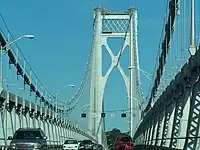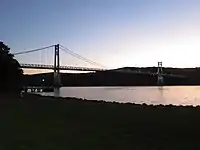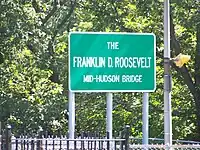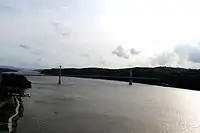Mid-Hudson Bridge
The Franklin Delano Roosevelt Mid-Hudson Bridge is a toll suspension bridge which carries US 44 and NY 55 across the Hudson River between Poughkeepsie and Highland in the state of New York.
Mid-Hudson Bridge | |
|---|---|
 | |
| Coordinates | 41°42′11″N 73°56′46″W |
| Carries | 3 lanes of |
| Crosses | Hudson River |
| Locale | Highland, New York and Poughkeepsie, New York |
| Official name | Franklin Delano Roosevelt Mid-Hudson Bridge |
| Maintained by | New York State Bridge Authority |
| Characteristics | |
| Design | Suspension bridge |
| Total length | 3,000 feet (910 m) |
| Longest span | 1,500 feet (460 m) |
| Clearance below | 135 feet (41 m) |
| History | |
| Opened | August 25, 1930 |
| Statistics | |
| Toll | (eastbound only) passenger cars $2.15 cash, $1.65 E-ZPass[1] |
| Location | |
History
Proposals for the Mid-Hudson span were made by state legislature in 1923. Although the Bear Mountain Bridge in Orange County, New York and the Holland Tunnel in Manhattan were under construction, there were then no fixed highway crossings south of Albany. Then-Governor of New York Alfred E. Smith signed the bill in June 1923. Construction would be undertaken by the New York State Department of Public Works (now the New York State Department of Transportation).
Construction began in 1925. Caissons weighing 66,000 tons were sunk into the riverbed; dirt was removed by crews working in a pressurized environment. The 315-foot-tall (96 m) Gothic steel towers were constructed in April 1929. Three years after opening, ownership was transferred to the New York State Bridge Authority in 1933, shortly after the Authority was created.
Then-Governor Franklin D. Roosevelt and his wife Eleanor attended the opening ceremony on August 25, 1930.
The toll plaza was originally located on the eastern side of the bridge, but was moved to the western side in Ulster County when a new highway approach was opened in December 1967.[2] Originally, tolls were collected in both directions. In August 1970, the toll was abolished for westbound drivers, and at the same time, eastbound drivers saw their tolls doubled. The tolls of eleven other New York–New Jersey and Hudson River crossings along a 130-mile (210 km) stretch, from the Outerbridge Crossing in the south to the Rip Van Winkle Bridge in the north, were also changed to eastbound-only at that time.[3]
The Mid-Hudson Bridge was designated as a New York State Historic Civil Engineering Landmark by the American Society of Civil Engineers in 1983.[2][4] The bridge was renamed the "Franklin Delano Roosevelt Mid-Hudson Bridge" in 1994.
In 2009, composer Joseph Bertolozzi completed Bridge Music, a project which allows listeners to hear the Mid-Hudson bridge played like a musical instrument. The work was created for New York's 400th anniversary observance of Henry Hudson's voyage up the Hudson. Originally intended to be a live performance piece,[2][5][6] this "audacious plan"[7] to compose music for a suspension bridge using the bridge itself as the instrument brought Bertolozzi wide international attention.[8] A recording of the results, the 2009 CD "Bridge Music" (on the Delos label DE1045), entered the Billboard Classical Crossover Music Chart at #18,[9] and has been released globally.
At midnight on March 1, 2022, the bridge was converted to all-electronic tolling in the eastbound direction.
Description
The bridge is 3,000 feet (910 m) long with a clearance of 135 feet (41 m) above the Hudson. At opening, it was the sixth-longest suspension bridge in the world. The chief engineer was Polish immigrant Ralph Modjeski, who had previously engineered the strengthening of the nearby Poughkeepsie Railroad bridge. Primary contractor was the American Bridge Company of Ambridge, Pennsylvania with steel from Carnegie. The span contains stiffening trusses intentionally constructed on top of the deck instead of below the deck.
The bridge carries three lanes of US 44 and NY 55 and a pedestrian/bicycle walkway over the Hudson. The bridge allows connections to US 9 on the east side, and US 9W to the west. The center lane is generally closed, except for rush hour traffic eastbound from 6am to 9am, and westbound from 3pm to 6pm. The center lane is also occasionally opened when work is being done on either side of the bridge. Five lane signals (referred to as "gantries" by NYSBA) indicate which lanes are open for travel. Approaches on either side of the bridge are four lanes, causing a bottleneck going onto the one- or two-lane span. The bridge has a computer-controlled LED decorative lighting system attached to the suspension cables, allowing the bridge to be decorated for Christmas (red, green) or the Fourth of July (red, white, and blue), and for other holidays.
In 2019, the bridge authority announced that tolls on its Hudson River crossings would increase each year beginning in 2020 and ending in 2023. As of May 1, 2021 the toll for passenger cars traveling eastbound on the Mid-Hudson Bridge was $1.75 in cash, $1.45 for E-ZPass users. In May 2022 tolls rose to $1.55 for E-ZPass users and $2 for cash payers. In 2023, the E-ZPass toll increased to $1.65, and the cash toll rose to $2.15[10][11]
 The bridge from the south-east
The bridge from the south-east Looking east on the Mid-Hudson Bridge
Looking east on the Mid-Hudson Bridge The bridge in twilight in 2019
The bridge in twilight in 2019 Sign bearing the official name of the span
Sign bearing the official name of the span The from the north, as seen from the Walkway Over the Hudson
The from the north, as seen from the Walkway Over the Hudson
See also
References
- "Toll Rates". New York State Bridge Authority. Retrieved July 11, 2022.
- "New York State Bridge Authority Mid Hudson Bridge Page". Archived from the original on July 28, 2012.
- Moran, Nancy (August 13, 1970). "One‐Way Tolls Confusing Some Drivers". The New York Times. Retrieved April 9, 2018.
- "Bridge Dedicated". Poughkeepsie Journal. September 28, 1983. p. 18.
- Young, Alison (July 1, 2007). "It's all in the ears of the beholder". Minnesota Public Radio. Archived from the original on June 8, 2011.
- "Reuters Video: Hudson River Bridge Used For Music". Reuters.
- Wakin, Daniel J.; John Schwartz (July 1, 2007). "Maestro Gives New Meaning to Traffic Jam". The New York Times. Retrieved August 28, 2012.
- "Bridge Music - Composer Joseph Bertolozzi". Archived from the original on August 9, 2009. Retrieved May 5, 2010.
- Moye, David (April 12, 2010). "Musician Hammering Out Deal to Play Eiffel Tower". AOL News. Archived from the original on May 27, 2010.
- Doxsey, Patricia (April 12, 2021). "Hudson River bridge tolls for E-ZPass users rise next month". Daily Freeman. Retrieved December 31, 2021.
- "Toll Rates". Retrieved November 28, 2022.
External links
- Historic American Engineering Record (HAER) No. NY-160, "Mid-Hudson Suspension Bridge"
- NYCroads Historic overview
- New York State Bridge Authority site
- Bridgemeister.com - Mid-Hudson Suspension Bridge
- Mid-Hudson Bridge at Structurae